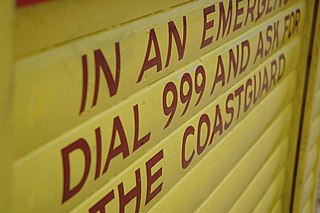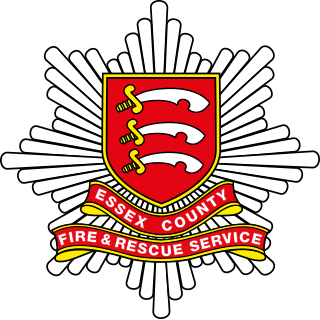Related Research Articles

999 is an official emergency telephone number in a number of countries which allows the caller to contact emergency services for emergency assistance. Countries and territories using the number include Bahrain, Bangladesh, Botswana, Eswatini, Ghana, Guernsey, Hong Kong, the Republic of Ireland, the Isle of Man, Jersey, Kenya, Macau, Malaysia, Mauritius, Poland, Qatar, Sudan, Saudi Arabia, Singapore, Trinidad and Tobago, Seychelles, Uganda, the United Arab Emirates, the United Kingdom, and Zimbabwe.

Search and rescue (SAR) is the search for and provision of aid to people who are in distress or imminent danger. The general field of search and rescue includes many specialty sub-fields, typically determined by the type of terrain the search is conducted over. These include mountain rescue; ground search and rescue, including the use of search and rescue dogs ; urban search and rescue in cities; combat search and rescue on the battlefield and air-sea rescue over water.

The 2003 Canberra bushfires caused severe damage to the suburbs and outer areas of Canberra, the capital city of Australia, during 18–22 January 2003. Almost 70% of the Australian Capital Territory's (ACT) pastures, pine plantations, and nature parks were severely damaged, and most of the Mount Stromlo Observatory was destroyed. After burning for a week around the edges of the ACT, the fires entered the suburbs of Canberra on 18 January 2003. Over the next ten hours, four people died, over 490 were injured, and 470 homes were destroyed or severely damaged, requiring a significant relief and reconstruction effort.

The New South Wales Rural Fire Service is a volunteer-based firefighting agency and statutory body of the Government of New South Wales.

The London Fire Brigade (LFB) is the fire and rescue service for London, the capital of the United Kingdom. It was formed by the Metropolitan Fire Brigade Act 1865, under the leadership of superintendent Eyre Massey Shaw. It has 5,992 staff, including 5,096 operational firefighters and officers based at 102 fire stations.
The Chief Fire Officers Association (CFOA) is the professional body representing senior fire officers in the United Kingdom. The organisation used to be known as the Chief and Assistant Chief Fire Officers Association, it was formed in 1974 following local government re-structuring. Since 2017, the operational activity of the CFOA has been delivered by the new National Fire Chiefs Council.

The fire services in the United Kingdom operate under separate legislative and administrative arrangements in England and Wales, Northern Ireland, and Scotland.

The Great Western Ambulance Service NHS Trust (GWAS) was a National Health Service (NHS) trust which provided emergency and non-emergency patient transport services to Bath and North East Somerset, Bristol, Gloucestershire, North Somerset, Swindon and Wiltshire, in South West England. It was formed on 1 April 2006 by the merger of the Avon, Gloucestershire and Wiltshire ambulance services. The ambulance service was acquired by neighbouring Foundation Trust South Western Ambulance Service (SWASFT) on 1 February 2013.
Bedfordshire Fire and Rescue Service is the fire and rescue service for the ceremonial county of Bedfordshire in England, consisting of the unitary authorities of Bedford, Central Bedfordshire, and Luton.

Devon and Somerset Fire and Rescue Service (DSFRS) is the statutory fire and rescue service covering the counties Devon and Somerset in South West England – an area of 3,924 square miles (10,160 km2). It serves a population of 1.75 million, and is the fifth largest fire and rescue service in the United Kingdom.

Essex County Fire and Rescue Service (ECFRS) is the statutory fire and rescue service for the county of Essex in the east of England, and is one of the largest fire services in the country, covering an area of 1,338 square miles (3,470 km2) and a population of over 1.7 million people.

Dorset Fire and Rescue Service is the former statutory Fire and Rescue Service for the area of Dorset, South West England. The Service Headquarters were located in Colliton Park, Dorchester, but as of October 2008 moved to a new purpose built location in Poundbury.
In the United Kingdom and Ireland, a retained firefighter, also known as an RDS firefighter or on-call firefighter, is a firefighter who does not work on a fire station full-time but is paid to spend long periods of time on call to respond to emergencies through the Retained Duty System. Many have full-time jobs outside of the fire service. Retained firefighters are employed and trained by the local fire and rescue service.

The New South Wales State Emergency Service, an agency of the Government of New South Wales, is an emergency and rescue service dedicated to assisting the community in times of natural and man-made disasters. The NSW SES is made up almost entirely of volunteer members, numbering over 10,214 as of July 2021. Members are easily identified by their distinctive orange overalls.

Cornwall Fire and Rescue Service is the statutory fire and rescue service covering Cornwall, England. As of April 2019, the service employs over 400 retained firefighters, 203 full-time firefighters, plus 170 support and administrative staff. Created under the Fire Services Act 1947 as "Cornwall County Fire Brigade", the name changed to "Cornwall Fire and Rescue Service" on 1 October 2009.
Firelink or FireLink is a wide area radio system in England, Wales, and Scotland for fire services. The system which supports both voice and data communication was designed to replace a patchwork of analogue systems with a modern wider area digital system. It provides new functionality – notably resilience and interoperability with other FRS and emergency services - which previous major incidents have identified as important.

The New Dimension programme, sometimes referred to as the New Dimension or New Dimensions, was started by the Department for Communities and Local Government in the UK, for fire and rescue services in England and Wales, following the September 11, 2001 attacks in the United States. It has provided equipment, training and standardised procedures to deal with terrorist attacks and major environmental disasters.
Wiltshire Emergency Services was a collaboration in the 1990s and early 2000s of the emergency services in Wiltshire, England, namely Wiltshire Police, Great Western Ambulance Service and Wiltshire Fire and Rescue Service. The primary element of this collaboration was the joint control centre in Devizes, which is now operated by the Wiltshire Police only. After both Wiltshire Fire and Rescue Service and the Great Western Ambulance Service ceased to exist following mergers with other services, the dedicated Wiltshire Emergency Services collaboration was abandoned in favour of collaborations between services across wider geographical areas.

The Scottish Fire and Rescue Service is the national fire and rescue service of Scotland. It was formed by the merger of eight regional fire services in the country on 1 April 2013. It thus became the largest fire brigade in the United Kingdom, surpassing the London Fire Brigade.

Emergency Management in Australia is a shared responsibility between the Government appointed body Emergency Management Australia and local councils.
References
- ↑ "Firelink: Improved fire and rescue service radio communications - Fire and resilience - Communities and Local Government". Archived from the original on 5 January 2008. Retrieved 20 September 2007.
- 1 2 3 "The Coalition: our programme for government" (PDF). HM Government, United Kingdom. 20 May 2010. Archived from the original (PDF) on 12 June 2011. Retrieved 20 May 2010.
- 1 2 3 "South West fire control in Taunton could be scrapped". BBC News. 21 May 2010. Retrieved 21 May 2010.
- ↑ "Regional fire brigade control centre plan scrapped". BBC News. 20 December 2010. Retrieved 7 January 2012.
- ↑ "FiReControl project - Fire and resilience - Communities and Local Government". Archived from the original on 5 May 2008. Retrieved 9 April 2008.
- ↑ "Airwave: Homepage". Archived from the original on 13 April 2008. Retrieved 9 April 2008.
- 1 2 3 4 5 6 7 8 9 "Progress on Fire Service new technology projects - Corporate - Communities and Local Government". www.communities.gov.uk. Archived from the original on 4 August 2009. Retrieved 13 January 2022.
- ↑ "East of England - Fire and resilience - Communities and Local Government". Archived from the original on 29 September 2008. Retrieved 7 July 2009.
- ↑ "East Midlands - Fire and resilience - Communities and Local Government". Archived from the original on 29 September 2008. Retrieved 6 April 2009.
- ↑ "London - Fire and resilience - Communities and Local Government". Archived from the original on 29 September 2008. Retrieved 3 April 2009.
- ↑ "Welcome to the FiReControl North East Website". Archived from the original on 20 August 2008. Retrieved 4 April 2009.
- ↑ "Home". nwfirecontrol.com.
- ↑ "South East - Fire and resilience - Communities and Local Government". Archived from the original on 29 September 2008. Retrieved 3 April 2009.
- ↑ http://www.swfirecontrol.co.uk Archived 2009-04-03 at the Wayback Machine
- ↑ "West Midlands - Fire and resilience - Communities and Local Government". Archived from the original on 29 September 2008. Retrieved 3 April 2009.
- ↑ "Yorkshire and Humberside - Fire and resilience - Communities and Local Government". Archived from the original on 29 September 2008. Retrieved 3 April 2009.
- ↑ "Project schedule - Fire and resilience - Communities and Local Government". Archived from the original on 22 June 2009. Retrieved 2 April 2009.
- ↑ "FiReControl - Communities and Local Government Committee Contents". UK Parliament. 8 February 2010. Retrieved 17 April 2010.
- ↑ "FILE ON 4" (PDF). BBC. 2 March 2010. Retrieved 17 April 2010.
- ↑ "FBU denounces failing fire control project as 'the worst ever'". tribunemagazine.co.uk. 19 March 2010. Archived from the original on 30 June 2012. Retrieved 17 April 2010.
- ↑ "Blast for 999 centre delays". Manchester Evening News. 1 April 2010. Retrieved 17 April 2010.
- ↑ "FRS Circular 3/2010 - Fire and Resilience Programme Highlights - January/February 2010". department of communities and local government. 26 February 2010. Archived from the original on 6 June 2012. Retrieved 17 April 2010.
- ↑ "Campaigns: Out of Control - Index". Archived from the original on 21 April 2008. Retrieved 9 April 2008.
- ↑ "Archived copy". www.conservatives.com. Archived from the original on 4 May 2009. Retrieved 13 January 2022.
{{cite web}}: CS1 maint: archived copy as title (link) - ↑ "Control room scrapping 'will help Devon and Somerset". BBC News. 20 December 2010. Retrieved 21 December 2010.